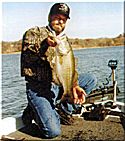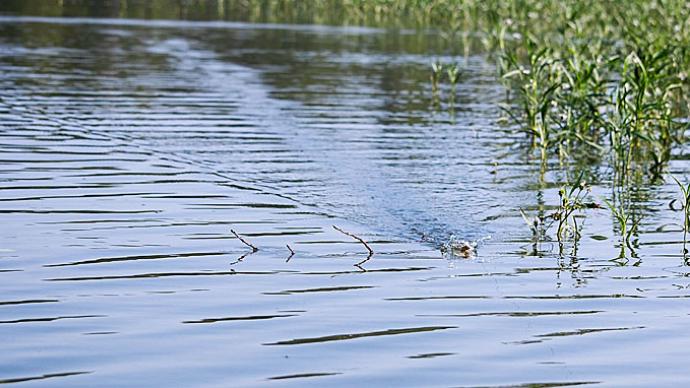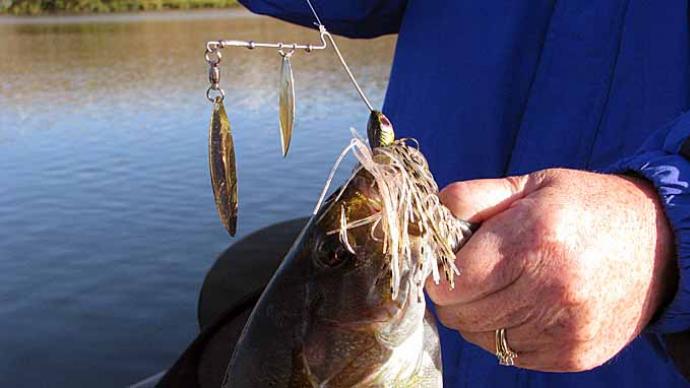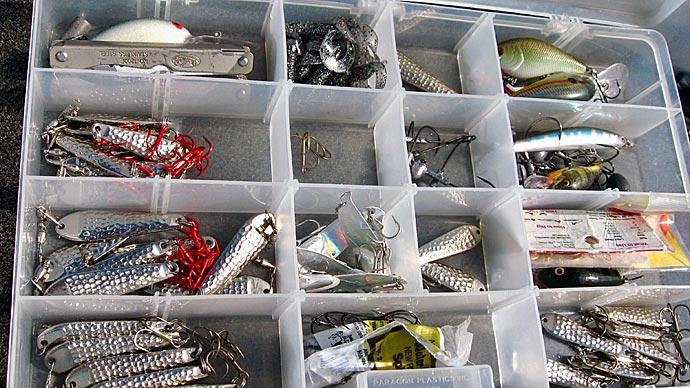
It was May the 15th, 2009. I was fishing a milfoil bed on the outside of a large spawning cove. The water temperature was 72 to 73 degrees. Up in the cove there were still a few males, and every now and then I saw a three- or four-pounder suspended by a dock post.
The reason I was fishing the point of milfoil was because I had kept a log for several years. I knew that a lot of large bass would stop off at this type of place before going on out to deeper structure for the summer. For the past week I had been catching a bunch of big bass on these same points. It had been easy to take a topwater, spinnerbait and floating worm and put 25 or 30 pounds in the boat in a hurry.
On this day, I had gone through my routine for four hours without a bite. As I was sitting in my boat trying to figure out what the heck happened, I remembered the day before seeing three good-sized bass swim by my boat headed for deeper water. I had seen this before, but never gave it much thought. I figured the sun had gotten high and maybe they saw me in the boat, but this had never affected my success until now.
I went ahead and tried to keep beating a dead horse though. When I got home that day I got my logbook out and began to read it.
June 14th, 2007. Fish have moved out to summer brush piles. Caught a 7.4, 6.8, 6.2 and 6.3. All on DD 22 crankbait, chartreuse. I flipped over to the next summer.
June 4th, 2008: Water temperature 80 degrees big bass have moved out to summer hangouts. Caught 9.6, 8.0, 7.7, 7. 1, and 5.6. Carolina rig and jiggin' spoon. Eighteen feet deep.
As I laid the logbook down, I kept thinking, okay, it's too early for them to be on the deep structure. They have got to be somewhere in between. When I unloaded the boat the next morning, I had a plan.
I intended to check about four possibilities. When I had gotten to the last one after about four hours of fishing and one two-pounder I had just about given up. I pulled up to a deep brush pile out on the end of a long tapered point. I was probably 300 yards off the bank. The other fishermen beating the milfoil looked out at me every now and then like they were trying to figure out if I was having boat trouble or sand bass fishing.
I threw out a half-hearted cast and started reeling. One tick of the willow limb in 17 feet of water was all it took. The big bass slammed my crankbait and came straight to the top. As she surfaced, I felt like everybody on the lake heard her.
I turned my body to hide the action from the other fishermen along the bank. I know this sounds silly, but you just don't know how many cousins I have that are always trying to beat me at fishing.
As I slid her over the side of the boat, I thought about the big bass I had seen the day before swimming out toward deeper water. I'm convinced now that these fish were leaving the shallows and going to their summer hangouts.
Shallow to deep is a very big statement. I'm going to try to explain what will happen, what might happen and what probably will happen as you're trying to figure this fishing scenario out. See, it's already confusing!
I think I can give you some logical tips on water conditions and techniques that will make this a whole lot easier and less confusing. Oh by the way, the bass weighed 10.01.
I threw my crankbait out again and when it came by the willow limb the second time I didn't get it back. Another bass took my bait all the way to the opposite side of the brush pile. With two half-hitches with a palomar knot for good measure, it broke my line anyway. I looked across the lake in time to see one of my cousins pull his truck under some willow trees and hide. I started up and drove off. It was too good a fishing hole to give away.
I don't know how big that fish was, but it was sure stout. This kind of action is common when you find them deep after the spawn.
For now, we're going to do like the fish. We'll start shallow and follow them to the deep water. One thing I want to do first is give you some guidelines.
In some lakes this shallow to deep migration doesn't take place. I would say probably in 90 percent of our lakes it does. Some lakes don't have humps in 20 feet of water or even have 20-foot depths, but another thing is that in some lakes the bass don't move deep during the summer months. This is due to the water quality, thermocline and water clarity.
Some lakes have a thermocline during the summer months. Some will have one very shallow and others may have two. I know this sounds confusing, but it's not as bad as it seems. I just want you to understand that in a few lakes the shallow to deep techniques that I'm going to explain won't work. Now back to where I was.
The spawn has just ended. This can be a difficult time for a lot of people to find and catch fish. Post spawn is something I am asked about often. The first thing I do is, think about the mood of the fish. Most of the time the bass won't be very aggressive during the post spawn time. Another thing that you should keep in the back of your mind is that post spawn bass seem to suspend a lot.
If I'm fishing a lake with a lot of docks, I'll look for bass to be suspended around the posts underneath. I'll basically use three types of lures when fishing for post spawn fish, topwaters, spinnerbaits and some type of worm, Slug-go, or trick worm. I normally don't use big baits. The fish just seem to be finicky during this period.
The fish will also be scattered. So I'll normally stay on the move until I hit on something productive. There's no better bait for this application than a Horizon spinnerbait.
As I said before I don't really like big baits at this time. The one thing I was impressed with about the Horizon 1/4-ounce spinnerbait was its vibration. I fish a lot of grass and this bait has the small profile of fry or other baitfish. It almost seems to call the fish out of the grass.
No matter what spinnerbait you prefer, I believe you'll do a lot better with the smaller versions. Sometimes I even trim the skirts, or take the skirt off and turn it around. Don't even think a big fish won't eat this up. I've caught a lot of big bass on Roadrunners this time of year. My dad, son and I crappie fish a lot and it always amazes me how many bass, some really big ones, we catch.
When you're fishing a spinnerbait you just have to let the fish tell you what they want. This factor can, and will, change from day to day. I have about four retrieves that I try. Sometimes the fish want the bait waked right under the surface. This is usually a sign of more aggressive fish. More times than not you have to either throw out and pull it back in at a steady retrieve or every time you bump something let the bait fall six to 10 inches, then swim it away from the cover pretty quickly. The last retrieve I try is the sweep. What I do is throw the bait out and let it fall to the bottom. Now, with your rod at 9:00 o'clock sweep it up to 12:00 o'clock.
What this does is make the bait come up about three feet, creating an arch that covers about a six-foot span. Repeat the movement all the way back to the boat.
Besides docks, I like to fish large flats, and any kind of little humps or ditches around spawning coves. These are great areas to find fish. Another area to seek bass is in the creek channel. Bass will often suspend in bushes and treetops right along the creek. I would say though, without a doubt, points are probably the number one spot. If you think about it, there are probably more bass caught off points any time of the year than on any other type of structure in a lake. Post spawn times will be no exception.
I'll use a topwater and a spinnerbait to locate fish. As far as I'm concerned, there are no better search baits on the market. Once I have established two or three areas holding fish, I'll take a wacky worm or Slug-go back through the areas. I may also try a Carolina rig as well, depending on what's off the bank from these spots. One thing I want to explain real quick is that the best way to organize post spawn in your mind is to picture where the fish have been, and where they're going. All bass have migration routes and "stop-off' places along the way. They have feeding areas and resting areas and sometimes these areas coincide with each other.
What I try to do, and I know this will help you too is imagine myself as an eight-pound bass. I use my depth finder to get a mental picture of the layout of the area. Then I think about how I would leave the spawning cove, imagine where I would stop and what trails I'd use. It can also be a great help to go look at these places when the lake is low.
When a lake is low, it's a good time to gain a wealth of knowledge about a particular area. Another thing you can do is look at the lay of the land above the water. Most of the time by looking closely at the surrounding land areas you can get a good idea about what's underwater.
I always use a trailer hook on a spinnerbait. Most of the time during post spawn you will be fishing for bass that are roaming. They're not holding tight to cover right now. A trailer hook will put 95 percent of your bites in the boat.
One of the best things you can do is let your imagination guide you. Be open-minded and creative. If you learn to figure out the little things and make it all work, it will make your confidence level soar.
Once the fish start leaving the banks, somewhere around the middle of May to the middle of June, they will move onto summer structure. I have found that my summer patterns can be more reliable than other times of the year. Again, some fish don't move deep even on lakes that have a thermocline. I place bass in four categories. There are fish that live shallow, some live mid-range, others are deep holding fish, and there are roamers.
Toward the first part of June the thermal heat from the sun will start to form a barrier underneath the surface of the water. This will normally be below the wave action, which can be three to five feet. As the heat increases and the winds decrease, this thermocline barrier will begin to sink. By mid-summer, on some lakes, it may settle at eight feet. On others it may go to 16 and on even others it may sink as deep as 25 to 30 feet. If the heat turns on in a hurry, I've seen this thermocline form in as little as a week to 10 days.
As I fish during the post spawn, I normally start checking mid-range and deeper structure on every trip to the lake. I'll do this once the water temperature reaches 70 degrees or above. Another thing I'll do in June is jump out of the boat in about five or six feet of water to physically check the depth of the thermocline or to see if it's formed. You might even remember that as a kid swimming, you might have wanted to see how far down the bottom was and just as you got to it, your feet would hit a cold spot. Right where the water gets cold, that was the thermocline barrier. In the summer bass will hold near this barrier.
Another great summer tactic is to fish jiggin' spoons. Jiggin' spoons actually became popular where people fished for lethargic winter bass. Most people don't utilize this great lure in the summer, but instead use crankbaits. But once you've established that there are fish holding over deep structure, a jiggin' spoon will put as many fish in the boat as a crankbait with a lot less effort. I've seen times when nothing could compare to it. First we'll talk about how deep the water needs to be. I have used jiggin' spoons by throwing them way out away from the boat and working them back. That's another story, for now we'll concentrate on fishing them straight down under the boat.
How deep you can utilize this technique depends on water clarity. I normally triple the water clarity. If I have three feet of visibility, I want to fish in at least nine feet or more. I have tried fishing jiggin' spoons under shallower than triple the depth of clarity, but without success. But keep in mind when you're fishing 10 feet or less you have to be super quiet. Which is why most of my jiggin' spoon fishing is done in 12 feet or deeper.
If I go to a lake I don't know, the first thing I do when I pull away from the ramp is, make sure my depth finder is set correctly. With the electronics we have today it is no problem to locate the thermocline. Set your finder on manual and run the sensitivity up to about 90 percent. Most depth finders will show a distinct line where the barrier is. Sometimes this may be sketchy lines that run all the way to the bottom. Where the lines start in the water is the thermocline. If you're still not sure all you have to do is look at the area where 90 percent of the fish are holding. They're holding on or right above the thermocline.
What I look for once I have established this depth, is structure along the line. During the summer I have my best luck on roadbeds, humps and ridges, tank dams, long points and some ledges. You can look at a map for these types of places or if you're familiar with the lake you may already fish these areas.
Sometimes I'll use my depth finder and a deep-diving crankbait to locate fish then I break out the jiggin' spoons. My two favorites are the Horizon Pirk Minnow and Luhr Jensen. I refer the 3/4-ounce sizes. These two baits are more streamlined and have a faster fall. Remember when jigging during the summer that the fish have a lot faster metabolisms. These more streamlined baits don't give the fish time to study them. They react a lot faster to them.
The key to fishing a jiggin' spoon is to kick the bait up on its side and let it flutter to the bottom. The way you do this is with a quick upward jerk. I try to hop the bait up on its side then follow it back to the bottom. Leave just a little slack in your line as you foIlow the bait back down.
Most bites will occur on the fall. But as with any lure you'll have to experiment. Don't be afraid to get pretty wild. Remember the fish are in 75- to 85-degree water. I promise you , they'll come out six to 10 feet to slam bait, some even more.
I recommend at least 17- to 20- pound line. Most of the time you'll be fishing around brush, rocks or bridge pilings. A six-foot medium-heavy rod works well, but use what feels best for you. It needs to be balanced with a pretty fast action for hook setting. Fishing a jiggin' spoon for hours can be tiring with the wrong equipment. Experiment with the action. Some days some fish may want the bait jumped up real high, others might want it just hopped six or eight inches off the bottom. If either of these actions goes dead I'll try casting the jiggin' spoon like a crankbait. Cast it as far as you can away from the boat and give it some slack so that it can fall straight down to the bottom. Once it's on the bottom, start hopping it back toward the boat. I'll normally hop it three or four feet then let it fall back to the bottom again.
You'd be amazed at what you find on the bottom. I've caught a lot of fish by hanging something then trolling over the top of it to dislodge my spoon. It might just be a small bush, but most of the time if there's fish in the area they'll hang around that bush. Don't worry if you do get hung up, most of the time you can get your jiggin' spoon back pretty easy. Just position your boat so you can get right over the top of it. Jiggle the rod up and down letting the spoon have some slack each time. The weight of the spoon will dislodge the hooks most of the time.
So to sum it up from shallow to deep, don't forget the mid-range fish. They're actually the least pressured since most fishermen beat the banks or fish deep with plastics. If you're more comfortable fishing eight to 14 feet of water then do so. But I'd really like you to try deep jiggin' in the summer, too. Most bass move out to deeper, more open, water. The places you need to look will, for the most part, be on the main lake.
Treat it like an adventure. Too often we grow up and get into a rut. Don't let this happen to you. Bass fishing is a never-ending process of learning. You have to keep that adventure and the thrill of discovering something new in your heart.
As always, keep a bait in the water.




